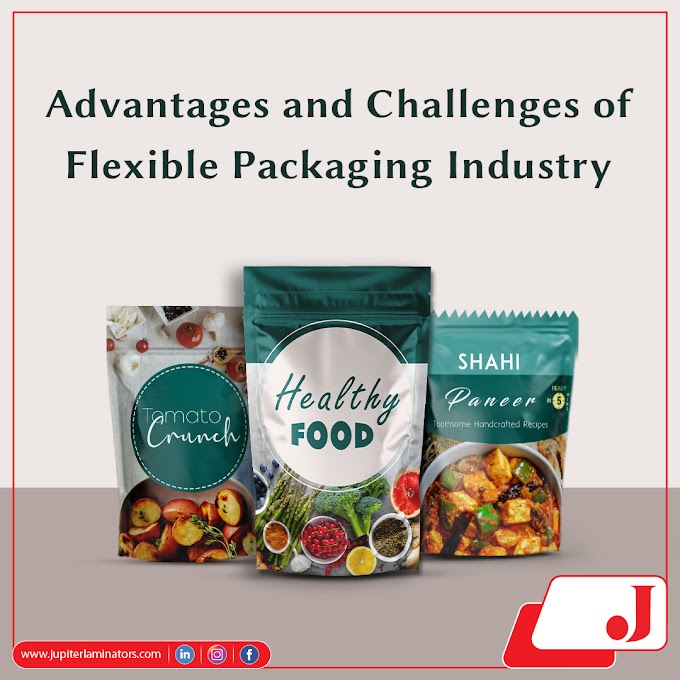Consumer preferences have changed over the past decade, as more customers prefer simplified packaging that also reduces waste associated with purchasing products. This trend is particularly pronounced in the food market, but a move towards flexible shipping materials can also be seen in mail order businesses of all kinds.
What Are The Benefits Of Good Flexible Packaging?
Jupiter Laminators
September 16, 2021
When considering a switch to flexible packaging, consider both the benefits and best practices, and
consider whether your products would do better in a flexible container.
What is flexible packaging?
This type of packaging covers a whole class of materials
and forms of construction. Simply put, it is any type of product packaging that
can be folded and folded during packaging and shipping. It can include sachets
and sachets.
Rigid packaging, on the other hand, includes cardboard
boxes and suitcase material, as well as anything that is stable and
dimensionally stable.
What are the advantages of flexible packaging?
Today's consumer preferences bring additional benefits to flexible
packaging beyond the strength and robustness of the design. For example, the
use of bags to deliver soft or flexible foods such as rice, soup mixes, honey,
sugar, and dry baking mixes means that the product comes in a strong but
flexible container that allows it to absorb shocks and compressions by changing
its shape. Stiff and brittle products like potato chips and pretzels require
care when handling, but flexible materials allow for minimal waste. The extra
air can protect the bag materials from damage by slightly inflating them,
reducing the risk of damage.
1. Lasts longer than
conventional packaging
Don't be fooled by the
flexibility of this packaging. In terms of durability, it is much stronger than
traditional glass and plastic, which can easily be damaged if mishandled or
accidentally dropped. Products that are packaged with modern flexible packaging
materials can reach the consumer without the contents being damaged or altered
by breakage.
2. Innovative and
creative designs
This type of packaging
allows manufacturers to be as creative as possible when designing their
products. Printing flexible
packaging and applying logos to your product packaging is much easier
than with conventional rigid media. The result is more attractive to the eyes.
This process gives manufacturers the ability to easily experiment with multiple
designs until they have a product design that they really want and that
resonates the most with customers.
3. Lightweight
This is probably the
most notable feature of flexible
packaging. Compared to conventional packaging such as glass or plastic
bottles, fewer raw materials are used in flexible packaging. This means that more packages
can be produced with less material and there are fewer packaging costs.
4. Economical
transportation
As mentioned above,
the flexible packaging
makes the products much lighter. This means that the products require less
storage space and lower transport costs since a truck can transport a greater number of packages. Conventional packaging methods are too restrictive and
quite bulky, leading to higher transportation costs.
5. Great branding and
marketing opportunities
This goes hand in hand
with an innovative design. Creative design means better branding of the
product. The way a product is branded, including color, size, and shape, affects
its competitiveness in the market. A good brand determines the adoption of the
product by consumers. This can influence whether a product is received
positively or rejected by customers.
6. Ensures product
safety
Flexible food packaging ensures product protection as it keeps food much safer and fresher
for longer. They are designed to protect products from moisture, oxygen, light,
and substances that can shorten the life cycle of the product.
7. Good for the
environment
One of the great
advantages of flexible packaging is that uses less material in its manufacture. The result
is less waste, less water, and energy consumption, and your company is helping
the environment by making packaging environmentally friendly. This means that
less electricity is used to prepare your products for shipment or to place them
in stores.
Conclusion
If you're not ready to
use flexible packaging
for your products, now may be the time to incorporate these benefits into your
design and manufacturing strategies. In short, it saves money on warehousing,
transportation, product packaging materials, and also makes products visually
appealing. Just go to a nearby supermarket and see how beautiful the products
look on the shelves in flexible
packaging and give them a try at your grocery store today.
Recent-Post
3/recent/post-list
Popular Posts

Advantages and Challenges of Flexible Packaging Industry
July 11, 2022

Recycling of Flexible Packaging & Other Materials
October 26, 2021

Stand-Up Pouches Holding the Market These days!
February 13, 2021
Recent Posts
3/recent/post-list
Translate
Jupiter Laminators- Largest Manufacturers in Flexible Packaging
Created By SoraTemplates | Distributed By Blogger Templates

0 Comments